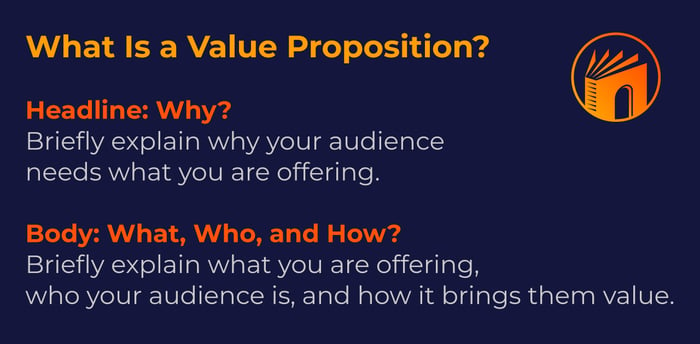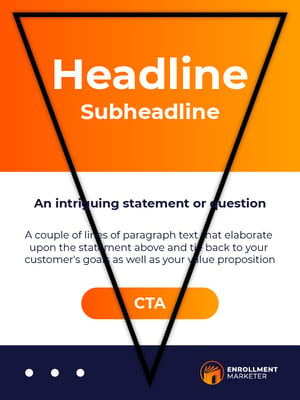How to Communicate Your College’s Value Proposition to Students
If you have ever made a purchase, you are probably familiar with the concept of a value proposition. Chances are you made that purchase because you perceived some value in the product or service. The same concept applies to colleges, universities, and other institutions of higher education.
Crafting an effective value proposition is a crucial component of inbound marketing in higher education. Your prospective students need to know what value you offer them, and your value proposition communicates this value to them.
In this post we will examine:
- What is a value proposition?
- How to write a value proposition for your school
- How to communicate your value proposition across channels
What is a Value Proposition?
In higher education, a value proposition is, simply put, a brief message that clearly communicates your school or program’s value to prospective students. A value proposition serves two main functions:
- To clearly communicate the primary value your school provides
- To place your school at the forefront of your prospects’ minds when compared to the competition
Ultimately, your objective is for your prospect to read your value proposition statement and immediately think “that’s exactly what I was looking for!” Therefore, having a thorough understanding of your prospects’ needs and objectives is crucial.
Key Components of a Value Proposition
There are three primary components of an effective value proposition:
- Your value proposition should resonate with your audience in a practical or emotional capacity
- Your value proposition should appeal to your target audience
- Your value proposition should set you apart from your competitors
Remember that your value proposition is one of the main ways your school or program will stand apart from your competition. If your school or program is not differentiated from your competitors in the mind of your target audience, they will have no reason to accept your proposition.
Building Blocks of a Value Proposition
When structuring your value propositions, there are three key elements you want to include:
- The headline: To make your value proposition stand out, you need to begin by crafting a clear, concise headline. Keep in mind, this headline is not a slogan or catchphrase, but is rather a concise communication of why your school or program is valuable to your audience.
- Subheadline/Paragraph: Underneath your headline include either a subheadline or brief paragraph explaining how your company or product brings value to your customers. Note that this should not be a rehash of your mission statement of company goals, but rather a clear communication of the value you bring to a customer.
- Visual Element: While perhaps not crucial, a visual element such as an image or video can really make your value proposition pop.

These elements are the building blocks of a value proposition.
How To Write a Value Proposition
The fundamental purpose of a value proposition is to communicate why prospective students and their families should choose your school or program over your competitors’. What unique value can you offer that your competitors cannot match? How does your program benefit the prospective student? If your audience doesn’t know why they should accept your proposition, they won’t.
An effective value proposition will answer the following questions:
1. Who is your audience?
Before crafting a value proposition, it is important to develop coherent student personas. Who does your value proposition benefit? The students? The parents? Make sure you have a clear target audience for your value proposition.
2. Why does your audience need what you provide?
This question is the core of your value proposition. Once you understand why your persona needs what you are offering, you can begin building your value proposition.
3. What can you offer them?
Are you creating a value proposition for your entire school? Or are you running a campaign for a particular program and need a value proposition for your landing page?
4. How does your college, university, or program bring them value?
How do students or parents benefit from what you are offering?
Remember that the who, the how, and the what are important, but if they do not work together to communicate the why, your value proposition will not hold water.
Here is a simple formula for crafting a value proposition. Keep in mind that this is not a universal requirement for building value propositions, but rather an easy way to get started.
- Headline: Why?
Briefly explain why your audience needs what you are offering. - Body: What, Who, and How?
Briefly explain what you are offering, who your audience is, and how it brings them value.

How To Communicate Your Value Proposition Across Channels
Now that you have built a clear value proposition, how can you get it in front of your audience? The method of communicating your value proposition is known as brand messaging. Here are four channels that you can use to present your value proposition to prospective students.
1. Homepage
If your audience is not able to determine the value of your website within the first 10-20 seconds, they are likely to become disinterested and leave your website. Therefore, in order to attract your visitors’ attention, your value proposition needs to be the first thing your audience sees. Be sure and put your value proposition at the front and center of your homepage to ensure that your website visitors don’t get bored and look elsewhere.
Keep in mind that on your homepage you want to communicate the value proposition of your entire school or program rather than individual subsets. If you are a higher education institution and the value proposition that displays on your website pertains to your Master’s degree program, your homepage will only be relevant to a portion of your audience. Instead, make sure you clearly and concisely communicate your school’s value proposition in a way that is relevant to your entire audience.
2. Landing Pages
Your landing pages are similar to your homepage in that you want your value proposition to be at the front and center of the page. However, in this situation your value proposition needs to align with the objective of your landing page rather than the whole school.
Usually, landing pages are designed with a clear intent to convert the visitor into a known contact or inquiry. In order to facilitate this conversion, your landing page will usually need to offer something of value to the visitor, and your value proposition should tie back to whatever that offer is.
For example, you may decide to create a career guide related to a particular degree, in which case your value proposition should speak to the “why” of why someone would benefit from downloading it. Alternatively, your individual program pages can be considered landing pages as well. In this case, the primary goal is an application, so your value proposition must speak to the value of applying to (and completing) the particular degree).
3. Social Media
On social media you have less time to communicate your message, as your audience is likely scrolling through their feed. Therefore, it is often important to make your value propositions stand out with attention-grabbing images and video. You should also likely use fewer words than you do on your website
4. Email Marketing
Emails have the potential to be intrusive rather than relevant, so it is important to segment your audience and establish your goals for your email marketing campaign. You can think of your email subject line as a mini value proposition. The subject line should be personalized and clearly communicate value to your audience. Remember that if your recipients don’t know why they should open your email, they won’t.
Once you have a solid subject line, the inverted pyramid model is an excellent way to structure your email. According to the model, your value proposition should be placed at the top of your email and drive your audience towards a call-to-action (CTA) at the bottom.

Next Steps:
Your value proposition is a key component of the enrollment marketing process. If you can communicate your value clearly and concisely, you will see marked improvement in your marketing campaigns. Interested in learning more? Subscribe to the Enrollment Marketer newsletter to receive helpful articles and resources right in your inbox that will help you learn about and stay on top of the world of enrollment management and marketing.



